Letters from Lodi
An insightful and objective look at viticulture and winemaking from the Lodi
Appellation and the growers and vintners behind these crafts. Told from the
perspective of multi-award winning wine journalist, Randy Caparoso.
How varietal character and terroir became generational bones of contention
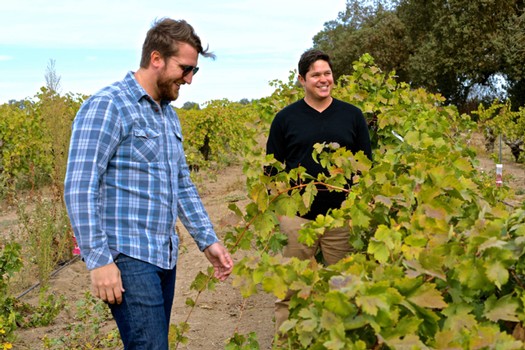
Marty Winters and Alex Pitts, co-owner/winemakers of Maître de Chai Wines, have been applying a radically different (leaner, less fruity and oaky) approach to old vine Lodi Zinfandel, reflecting a generational shift in quality standards.
An indictment of varietal character
Among all the quality factors by which American wines have been evaluated, the most onerous, and increasingly dubious, is the conception of "varietal character."
Varietal character is the term used to describe sensory qualities associated with a particular grape identified on the label of a bottling. For instance, the varietal character of a Cabernet Sauvignon is often considered to be a red wine that exudes aromas of blackcurrant, dark berries, some degree of herbaceousness, and a full body and generous tannin. The varietal expectation of a Zinfandel is that of a very berry-like red wine, medium to full in body/tannin and zesty in flavor.
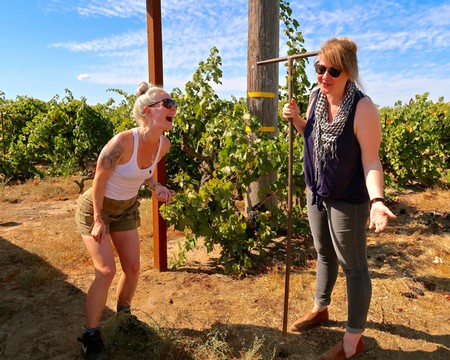
Texas sommeliers Ali Martin and Krista Church, visiting Lodi in 2019 to study old vine growths, have since cultivated a newfound appreciation of the softer, more fragrant yet earth toned styles of Zinfandel unique to Lodi terroirs.
Thus, when evaluating varietal wines, it is all to easy to measure quality in terms of sheer intensity of varietal character. The numerical scoring systems favored by many wine critics tend to exacerbate this line of thought: That the more a Cabernet Sauvignon and Zinfandel taste like a "Cabernet Sauvignon" or "Zinfandel," the higher the score and, presumably, the better the wine.
The drawback of evaluating wine quality in terms of intensity of varietal character is that, as in all things, perception is everything. Wine critics, for one, tend to have differing conceptions of what constitutes a varietal wine's ideal qualities, and the perspectives of wine critics in general have grown increasingly different from that of, say, the sommelier trade, which tends to define quality in terms of other factors, such as sense of balance, or the presence of non-fruit sensations such as earthiness or minerality.
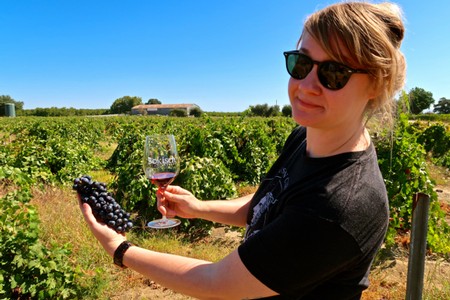
Sommelier Krista Church learning to appreciate Lodi Zinfandel in terms of Lodi-grown grape morphology.
In fact, if you've met a sommelier or two — especially those in their twenties and early thirties — you may have noticed that their perception of varietal character is almost the opposite of older generations of wine professionals working in the trade or media. Intensity of fruitiness as well as sensory qualities such as body (closely related to alcohol levels), tannin and oak are largely considered negatives. It is now almost safe to predict, when tasting a wine that is lean, sharp with acidity, soft in tannin, earthy (in the absence of fruitiness) and sometimes even oxidized, that this would be "sommelier's wine."

Patrick Cappiello, originally a New York sommelier, who now produces Lodi-grown Zinfandels, Petite Sirahs and a Mission under his Monte Rio label with startlingly different sensory objectives (lightness rather than heaviness, and subtlety rather than intensity of fruit or oakiness).
This is no indictment of sommeliers. Who is even surprised that the tastes of younger people are graphically different from that of previous generations? They dress differently, they listen to different music, and so of course their perception of wine quality is different.
More than anything, it is an indictment of the arbitrary nature of concepts like varietal character: That all wines, when made from the same grape, must meet the exact same standards, which invariably ends up being the "bigger" or "richer" the better. With the benefit of more information and access to a far greater variety of winess, younger people — not just sommeliers, but also more and more consumers — can no longer think in those terms. Not only is bigger no longer considered better, it is considered lesser.
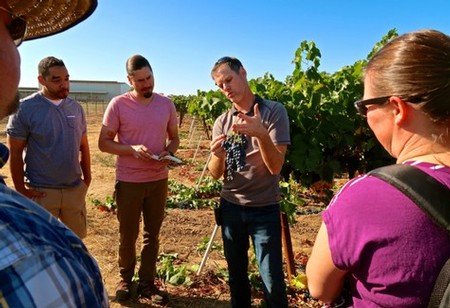
LangeTwins Family's Aaron Lange demonstrating Lodi-grown Nero d'Avola to young sommeliers.
Growing interest in terroir
If anything, as a result of having a wider range of wines from around the world to choose from, both sommeliers and consumers have begun to think of wine quality more and more in terms of terroir, regardless of how well a wine meets varietal expectations. If there is another term that has been a bone of contention among generations, it's terroir, usually defined as a wine's "sense of place" resulting from growing conditions associated with different regions, vineyards, and even individual blocks or rows within vineyards.
It is not as if older generations of wine lovers don't appreciate wines from individual vineyards. It is simply that they consider intensity of varietal character to be more far more important quality factors than regional or vineyard-related distinctions. Not too long ago, a U.C. Davis professor even went so far as to publish a book declaring terroir to be a "myth," and nothing more than a "shibboleth that establishes an in-group in a world unto itself... this isn't wine appreciation... it is more like wine snobbery" (re Matthews, Terroir and Other Myths of Winegrowing).
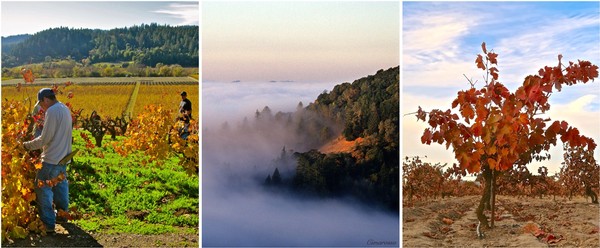
From left, Dry Creek Valley, Howell Mountain and Mokelumne River-Lodi — three appellations bearing litle physical resemblance (so why would anyone expect Zinfandels from these regions to meet the same varietal expectations?).
Yet, since the growing conditions or terroirs of, say, Rutherford in Napa Valley and the Adelaida District in Paso Robles are so graphically different, it has never made any sense to evaluate these region's Cabernet Sauvignons in terms of the same varietal profile. The same thing applies to Zinfandel grown in Sonoma County's Dry Creek Valley or Napa Valley's Howell Mountain as opposed to Lodi's Mokelumne River. Physically, these regions barely resemble each other. Why would anyone expect their Zinfandels to meet the same specific quality or varietal expectations?
You can take this one step further and compare Zinfandels planted on the west side of Mokelumne River (that is, west of the railroad tracks that run through the City of Lodi) with Zinfandels planted on the east side. Since the soils on Lodi's east side are considerably sandier, Zinfandel plants and clusters do not even grow in the exact same way. Therefore, east side Lodi Zinfandels are more fragrant in red berry qualities, whereas on the west side Lodi Zinfandels come out with darker berry qualities plus with a more discernible earthiness in comparison to Zinfandels grown on the east side. In view of these basic observations, it's hard to conclude that terroir, or vineyard -related distinctions, is something mythical. Anyone with two eyes, a nose, a tongue and common sense can tell the difference.
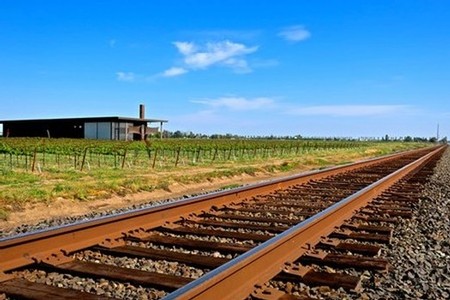
The historical Central Pacific Railroad tracks (now operated by Southern Pacific Railroad) running through the middle of Lodi's Mokelumne River AVA.
Whatever the case may be, the movement away from expectations of varietal character has been an inevitable part of the evolution of the American consumer, trade and media, as more and more commercial wines are appreciated for their representation of respective regions or vineyards rather than fulfillment of varietal expectations. This way of looking at wine, in fact, is far from new. It has long associated with the finest wines of Europe, which are largely labeled by place names rather than by the brand/varietal formula that began to typify the American wine industry in the 1970s.
Old timers can well recall that during the 1960s and '70s varietal wines were just beginning to supplant generic wines, as well as sweet fortified wines, in popularity. It is the obsession with brand styles and varietal character which drove this first phase of America's appreciation for premium wines that explains the generational gap we see today. As good and interesting as they were, the American wines of the '60, '70s, and all the way through the '90s were not nearly as distinctive or geographically diverse as they are today.

Classic print ad for Paul Masson Pinot Chardonnay (a varietal now correctly called Chardonnay) from the 1970s — an era when Americans were just beginning to understand and appreciate varietal characteristics, and vineyard or appellation-related distinctions were not on anyone's radar.
Consequently, up until very recently, sensory characteristics associated with regions or vineyards drew huge blanks in the minds of much of the trade, media and consumers. Out of sight, out of mind. But those days are gone. Much of the American wine industry, particularly on the artisanal side, has changed its approach to wine styles. Factors like appellations, and vineyard sourcing, are more important than ever. This, in turn, has been making bigger and bigger impacts on commercial styles and consumer preferences. Anyone who thinks that it's just sommeliers who are beginning to prefer lighter, leaner, less fruity or oaky wines is just fooling themselves. The times, as the bard once put it, they are a-changin'.
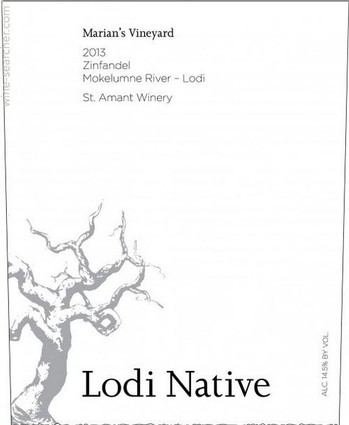
A recent Lodi Native wine label reflecting a more contemporary thought process, where the vineyard source (Marian's Vineyard) is more strongly emphasized than the wine's varietal identity (Zinfandel).
The changes are even being felt in Lodi, America's largest grower of grapes for commercial wine production. In order to compete with regions in the rest of California and around the world, Lodi growers have been hard at work establishing an identity that can't be duplicated elsewhere. What does Lodi have in spades, compared to other wine regions? For one, a very dependable, sun soaked Mediterranean climate — not too hot, not too cold, never too windy or dry (lots and lots of water from the nearby Sierra Nevada). A real Goldlilocks. Wine grapes love these conditions, but they produce red wines that are lush in fruit and soft in tannin. White wines are just as floral and flavorful as whites from other regions, yet just as crisp and refreshing.
The key to Lodi establishing its own unique identity, in other words, has been to play up the qualities of its wines that are intrinsic in its grapes. And those qualities are, indubitably, tied directly to the region's growing conditions. More simply put, terroir. And the sooner we can all start appreciating wines for their distinctions related to terroir, rather than just for varietal qualities which can come from anywhere or be defined in any arbitrary way, the better off we'll all be as aficionados of wine and wine regions.
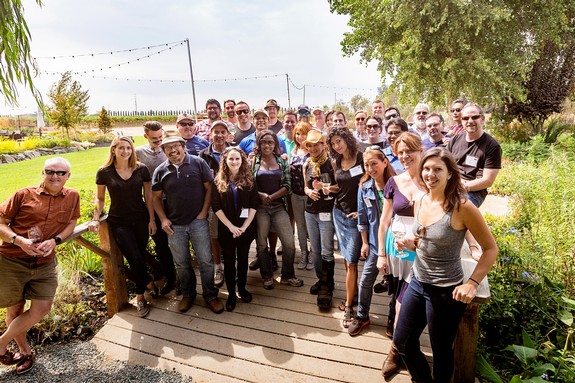
Michael David Winery co-owner David Phillips (left) with visiting sommeliers, largely in their twenties and thirties, during a 3-day Lodi SOMM Camp in 2015.